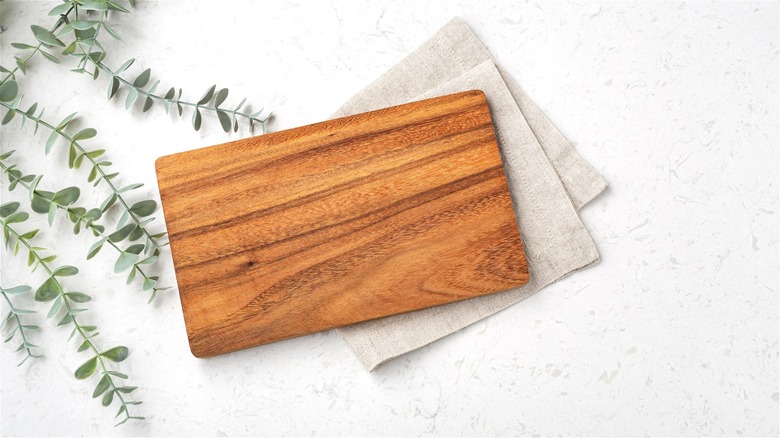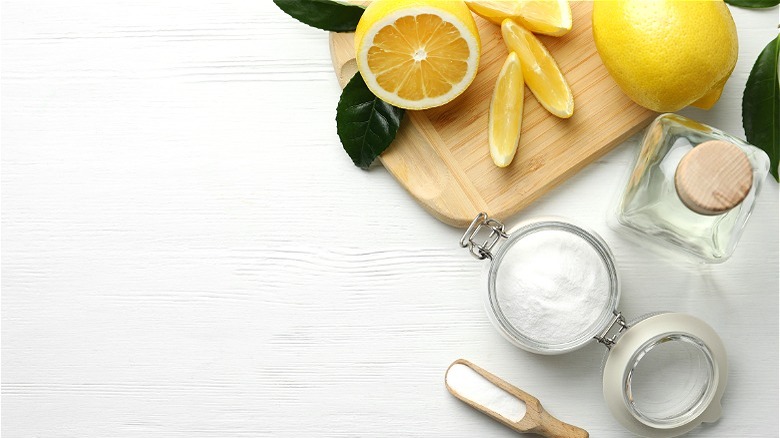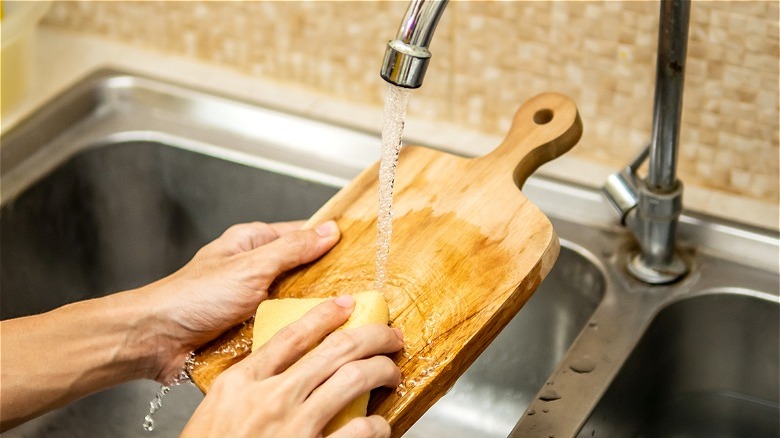The Baking Soda Trick To Revive Your Cutting Board
You probably don't remember the time you were too lazy to use a cutting board to slice an apple or cut the base off a head of broccoli but unfortunately, your kitchen counter does. Cutting boards have more than one essential function in the kitchen. Not only do they prevent countertops from getting dinged and scored amidst food preparation, but these sturdy wood slabs and thin, durable sheets of plastic help you maintain food safety standards when handling various meat cuts, dairy, and fresh produce.
Rapid production in modern America has also expanded our range of cutting board options. Modern cutting boards aren't just made of wood. These kitchen necessities are also made from plastic, glass, bamboo, and even silicone. Yet for many of us, wood is the trusted material of choice. Wood cutting boards, historically known as butcher blocks, have been used in China and Europe since the early 15th century. While originally used to tenderize and prepare large cuts of meat, nowadays you might choose a wooden cutting board for its sleek modern design and because naturally sourced boards hold up well to extended everyday use, potentially lasting over a decade. Yet, if not properly cared for over time, simply looking at your cutting board might give you pause when you consider the dull sheen it's taken on over the years. Surprisingly, baking soda may be the solution you need to bring your old wooden board back to life.
Use baking soda to make your favorite cutting board look like new
If you've had the same cutting board for years, it's probably looking a bit drab and needs some revitalizing. If you have a wood cutting board, you already know the process behind seasoning: By covering the surface of your cutting board with mineral oil, you directly prevent any food particles or odors from seeping into any unseen cracks. However, with extended use, boards become worn and may need an additional step or two to help restore their overall quality.
Most of us already know how to use lemon juice to gauge the freshness of baking soda, but surprisingly that same bubbling reaction also works wonders for your favorite cutting board. This easy method is showcased in a popular TikTok video where a woman sprinkles a generous amount of baking soda over a large wooden cutting board, squeezes lemon juice over the white dust, and scrubs the board with lemon halves. After the board is scrubbed, it's rinsed with water and looks brand new.
Everyone wants a rejuvenated cutting board and with a few simple ingredients, why not give this method a try? However, lemons and baking soda won't necessarily clean your trusted board. According to the Wirecutter, baking soda and lemon are often used as deodorizers but do not reduce or remove residual bacteria from food preparation. While having a shiny cutting board is nice, what is the best way to clean a wooden cutting board?
How to properly clean a wood cutting board
Lemons and baking soda aren't the only ingredients to eliminate pesky odors from your favorite cutting board. You can also use salt or vinegar, and the latter also works as a handy cleaner to remove unwanted bacteria. Aside from vinegar though, is there a best course of action for cleaning a wood cutting board? Unfortunately, you should never place a wood board in your dishwasher, so hand washing your cutting board is always recommended. Choose a mild soap and wash both sides of the board, sitting the wood upright to dry so water can safely drip down the surface.
Regardless of how often you deodorize or clean your cutting board, the most important factor to remember is consistent seasoning. This process prevents your cutting board from becoming dry and possibly cracking over time. Use an affordable mineral oil and try to moisten your clean board once per month. After oiling, always make sure to allow the oil to soak into the wood for hours at a time before wiping it clean to resume use. To fully prevent bacteria from spreading during food preparation, aim to use two separate cutting boards and always replace your wooden board once it appears heavily marked or the grooves have become noticeably deep. If your board is weathered but appears to still be in good shape, give it the occasional lemon and baking soda treatment for an extra boost of life.


